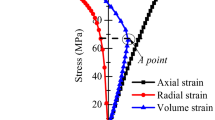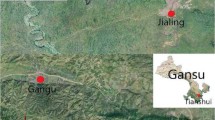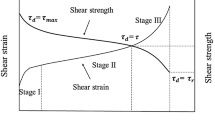Abstract
Creep exerts a significant role in rock engineering safety. In engineering practice, it is helpful to develop a mathematical model representing rock creep behaviors. We used a shear rheometer to carry out shear creep tests of cubic mudstone specimens. The experimental results indicate that the mudstone creep can be divided into steady and accelerated stages when the applied shear stress is greater than the long-term shear strength. To capture the creep characteristics of the mudstone samples, in this paper, we propose a variable-parameter fractional derivative element based on fractional theory. A viscosity coefficient is considered to be a variable. We develop a mathematical model describing rock shear creep. The new model shows a visco-elastic-plastic property, which can effectively characterize two stages of rock creep process. The shear creep results show that the new model of shear creep is more accurate than that of the Nishihara model and the constant-parameter fractional creep model. Sensitivity analysis demonstrates that derivative orders have the greatest effect on shear creep.









Similar content being viewed by others

Abbreviations
- \(\tau _{0}\) :
-
A constant shear stress
- \(\tau _{s}\) :
-
Long-term shear strength
- \(G,G_{1},G_{2}\) :
-
Shear modulus
- \(\eta ,\eta _{1},\eta _{2}\) :
-
Viscosity coefficients
- \(\beta ,\beta _{1}\) :
-
Derivative orders
- \(\tau \) :
-
Shear stress
- \(t\) :
-
Time
- \(A_{1},B_{1},\beta _{1}\) :
-
The parameters describing the accelerated creep
- \(\sigma _{m}\delta _{ij}\) :
-
Spherical stress tensor
- \(K\) :
-
Bulk modulus
- \(\sigma _{0}\) :
-
Constant normal stress
- \(\sigma _{3}\) :
-
Confining pressure
- \(c,\varphi \) :
-
Cohesion and internal friction angle
- \(\varepsilon _{i}^{\mathrm{tes}},\varepsilon _{i}^{\mathrm{cal}}\) :
-
Tested strain and calculated strain
- \(\overline{\varepsilon ^{\mathrm{tes}}}\) :
-
Average tested strain
- \(e_{ij}\) :
-
Deviatoric strain tensor
- \(S_{ij}\) :
-
Deviatoric stress tensor
- \(\sigma _{kk}\) :
-
First stress tensor invariant
- \(\varepsilon _{kk}\) :
-
First strain tensor invariant
- \(\varepsilon _{ij}\) :
-
Total strain
References
Adolfsson, K., Enelund, M., Olsson, P.: On the fractional order model of viscoelasticity. Mech. Time-Depend. Mater. 9(1), 15–34 (2005)
Chen, H.J., Xu, W.Y., Wang, W., Wang, R.B., Shi, C.: A nonlinear viscoelastic-plastic rheological model for rocks based on fractional derivative theory. Int. J. Mod. Phys. B 27(25), 1350149 (2013)
Colmenares, L.B., Zoback, M.D.: A statistical evaluation of intact rock failure criteria constrained by polyaxial test data for five different rocks. Int. J. Rock Mech. Min. Sci. 39(6), 695–729 (2002)
Fabre, G., Pellet, F.: Creep and time-dependent damage in argillaceous rocks. Int. J. Rock Mech. Min. Sci. 43(6), 950–960 (2006)
Guan, Z., Jiang, Y., Tanabashi, Y.: Rheological parameter estimation for the prediction of long-term deformations in conventional tunnelling. Tunn. Undergr. Space Technol. 24(3), 250–259 (2009)
Güneyisi, E., Gesoglu, M., Naji, N., İpek, S.: Evaluation of the rheological behavior of fresh self-compacting rubberized concrete by using the herschel–bulkley and modified Bingham models. Arch. Civ. Mech. Eng. 16(1), 9–19 (2016)
He, Z.L., Zhu, Z.D., Zhu, M.L.: An unsteady creep constitutive model based on fractional order derivatives. Rock Soil Mech. 37(1), 737–744 (2016) (in Chinese)
Huang, R.Q., Wu, L.Z., He, Q., Li, J.H.: Stress intensity factor analysis and the stability of overhanging rock. Rock Mech. Rock Eng. 50(8), 2135–2142 (2017)
Huang, R.Q., Wu, L.Z., He, Q., Li, J.H.: Crack initiation criteria and fracture simulation for pre-cracked sandstones. Adv. Mater. Sci. Eng. (2019) https://doi.org/10.1155/2019/9359410.2019.9359410
Jiang, Q.H., Qi, Y.J., Wang, Z.J., Zhou, C.B.: An extended Nishihara model for the description of three stages of sandstone creep. Geophys. J. Int. 193(2), 841–854 (2013)
Jin, Y.F., Yin, Z.Y., Riou, Y., Hicher, P.Y.: Identifying creep and destructuration related soil parameters by optimization methods. KSCE J. Civ. Eng. 21(4), 1–12 (2017)
Liao, M.K., Lai, Y.M., Liu, E.L., Wan, X.: A fractional order creep constitutive model of warm frozen silt. Acta Geotech. 12, 377–389 (2017)
Liu, H.Z., Xie, H.Q., He, J.D., Xiao, M.L., Zhuo, L.: Nonlinear creep damage constitutive model for soft rocks. Mech. Time-Depend. Mater. 21(1), 1–24 (2016)
Lin, F., Wu, L.Z., Huang, R.Q., Zhang, H.: Formation and characteristics of the Xiaoba Landslide in Fuquan, Guizhou, China. Landslides 15(4), 669–681 (2018)
Ma, L.J., Liu, X.Y., Fang, Q., Xu, H.F., Xia, H.M., Li, E.B.: A new elasto-viscoplastic damage model combined with the generalized Hoek–Brown failure criterion for bedded rock salt and its application. Rock Mech. Rock Eng. 46(1), 53–66 (2013)
Ma, L.J., Wang, M.Y., Zhang, N., Fan, P., Li, J.: A variable-parameter creep damage model incorporating the effects of loading frequency for rock salt and its application in a bedded storage cavern. Rock Mech. Rock Eng. 50(3), 1–15 (2017)
Maranini, E., Brignoli, M.: Creep behaviour of a weak rock: experimental characterization. Int. J. Rock Mech. Min. Sci. 36(1), 127–138 (1999)
Shen, J.Y., Jimenez, R., Karakus, M., Xu, C.S.: A simplifified failure criterion for intact rocks based on rock type and uniaxial compressive strength. Rock Mech. Rock Eng. 47, 357–369 (2014)
Sun, Y.F., Chen, C.: Fractional order creep model for coral sand. Mech. Time-Depend. Mater. 23(4), 465–476 (2018)
Tang, H., Wang, D.P., Huang, R.Q., Pei, X.J., Chen, W.: A new rock creep model based on variable-order fractional derivatives and continuum damage mechanics. Bull. Eng. Geol. Environ. 77(1), 1–9 (2017)
Tomanovic, Z.: Rheological model of soft rock creep based on the tests on marl. Mech. Time-Depend. Mater. 10(2), 135–154 (2006)
Urai, J.L., Spiers, C.J., Zwart, H.J., Lister, G.S.: Weakening of rock salt by water during long-term creep. Nature 324, 554–557 (1986)
Wang, Z.J., Qiang, H.F., Wang, T.J., Wang, G., Hou, X.: A thermovisco-hyperelastic constitutive model of HTPB propellant with damage at intermediate strain rates. Mech. Time-Depend. Mater. 22, 291–314 (2018)
Wu, F., Xie, H.P., Liu, J.F., Bian, Y., Peng, J.L.: Experimental suudy of fractional viscoelastic-plastic creep model. Chin. J. Rock Mech. Eng. 33(5), 964–970 (2014) (in Chinese)
Wu, F., Liu, J.F., Wang, J.: An improved Maxwell creep model for rock based on variable-order fractional derivatives. Environ. Earth Sci. 73(11), 6965–6971 (2015)
Wu, L.Z., Li, B., Huang, R.Q., Sun, P.: Experimental study and modeling of shear rheology in sandstone with non-persistent joints. Eng. Geol. 222, 201–211 (2017)
Wu, L.Z., Shao, G.Q., Huang, R.Q., He, Q.: Overhanging rock: theoretical, physical and numerical modeling. Rock Mech. Rock Eng. 51(11), 3585–3597 (2018)
Wu, L.Z., Deng, H., Huang, R.Q., Zhang, L.M., Guo, X.G., Zhou, Y.: Evolution of lakes created by landslide dams and the role of dam erosion: a case study of the Jiajun landslide on the Dadu River, China. Quat. Int. 503A, 41–50 (2019a)
Wu, L.Z., Li, S.H., Sun, P., Huang, R.Q., Li, B.: Shear creep tests on fissured mudstone and an improved time-dependent model. Pure Appl. Geophys. 176(11), 4797–4808 (2019b)
Wu, L.Z., Li, S.H., Zhang, M., Zhang, L.M.: A new method for classifying rock mass quality based on MCS and TOPSIS. Env Ear. Sci. 78(6), 199–199 (2019c)
Yan, B.Q., Guo, Q.F., Ren, F.H., Cai, M.F.: Modified Nishihara model and experimental verification of deep rock mass under the water–rock interaction. Int. J. Rock Min. Sci. (2020). https://doi.org/10.1016/j.ijrmms.2020.104250
Yang, S.Q., Cheng, H.: Non-stationary and nonlinear visco-elastic shear creep model for shale. Int. J. Rock Mech. Min. Sci. 48(6), 1011–1020 (2011)
Yang, W.D., Zhang, Q.Y., Li, S.C., Wang, S.: Time-dependent behavior of diabase and a nonlinear creep model. Rock Mech. Rock Eng. 47(4), 1211–1224 (2014)
Yin, D.S., Ren, J.J., He, C.L.: A new creep model element for geomaterials. Chin. J. Rock Mech. Eng. 26(9), 1899–1903 (2007) (in Chinese)
Yin, D.S., Wu, H., Cheng, C., Chen, Y.Q.: Fractional order constitutive model of geomaterials under the condition of triaxial test. Int. J. Numer. Anal. Methods Geomech. 37(8), 961–972 (2013)
Zhang, Q.Y., Xiang, W., Jiang, L.Y.: A thermal-visco-elastoplastic damage creep model for gneissic granite and its practical application. China Civ. Eng. J. 50(8), 88–97 (2017a) (in Chinese)
Zhang, Q.Y., Zhang, L.Y., Xiang, W.: Triaxial creep test of gneissic granite considering thermal effect. Rock Soil Mech. 38(9), 2507–2514 (2017b) (in Chinese)
Zhou, H.W., Wang, C.P., Han, B.B., Duan, Z.Q.: A creep constitutive model for salt rock based on fractional derivatives. Int. J. Rock Mech. Min. Sci. 48(1), 116–121 (2011)
Acknowledgements
We thank the National Key R&D Program of China (No. 2018YFC1504702), the National Natural Science Foundation of China (No. 41672282), and the State Key Laboratory of Geohazard Prevention and Geoenvironment Prevention Independent Research Project (No. SKLGP2019Z010).
Author information
Authors and Affiliations
Corresponding author
Ethics declarations
Conflict of interest
The authors declare that they have no conflict of interest.
Additional information
Publisher’s Note
Springer Nature remains neutral with regard to jurisdictional claims in published maps and institutional affiliations.
Appendices
Appendix A
Before deriving the equations, we give necessary mathematical definitions.
-
a.
Fractional integral definition
Let \(\beta \in R^{ +} \). If \(f(x) \in L^{1}(R^{ +} )\), then the \(\beta \)th-order Riemann–Liouville (R-L) integral is defined as:
$$ \mathrm{I}^{\beta } f(x) = \frac{1}{\Gamma (\beta )}\int _{0}^{x} \frac{f(s)}{(x - s)^{1 - \beta }} ds. $$(A.1) -
b.
Gamma function and its properties
The gamma function is defined as:
$$ \Gamma (p) = \int _{0}^{\infty } e^{ - x}x^{p - 1}dx,\qquad p>0. $$(A.2)The properties of the gamma function:
$$\begin{aligned} &\Gamma (1) = 1, \end{aligned}$$(A.3)$$\begin{aligned} &\Gamma (p + 1) = p\Gamma (p). \end{aligned}$$(A.4) -
c.
Beta function
The beta function \(\beta (m, n)\) is defined as:
$$ \beta (m,n) = \int _{0}^{1} x^{m - 1}(1 - x)^{n - 1}dx = \frac{\Gamma (m)\Gamma (n)}{\Gamma (m + n)}. $$(A.5)
1.1 A.1 Derivation of Eq. (7)
Equations (6a)–(6b) can be transformed into
Solving Eq. (A.6), based on the definition a, b, and c above, we have:
1.2 A.2 Proof of two special forms of new components
The variable-parameter elastic element can be expressed as:
The variable-parameter viscous element can be expressed as:
This can be proved by letting \(\beta=0\), 1 in Equation (7).
Appendix B: Three-dimensional form of the new model
A three-dimensional constitutive relationship is expressed as (Jiang et al. 2013; Liao et al. 2017):
where \(e_{ij}\) and \(S_{ij}\) are the deviatoric strain and stress tensors, respectivelym and \(\sigma _{kk}\) and \(\varepsilon _{kk}\) are the first stress tensor invariant and first strain tensor invariant, respectively. The total strain is
Substituting Eqs. (B.1) and (B.2) into Eq. (10) and noting that \(\sigma _{kk}\) and \(\varepsilon _{kk}\) only affect the instantaneous creep, we can obtain Eq. (11). Substituting the Mises yield condition and the DP yield criterion into Eq. (11), we can derive Eqs. (12) and (13).
Rights and permissions
About this article
Cite this article
Wu, L.Z., Luo, X.H. & Li, S.H. A new model of shear creep and its experimental verification. Mech Time-Depend Mater 25, 429–446 (2021). https://doi.org/10.1007/s11043-020-09453-1
Received:
Accepted:
Published:
Issue Date:
DOI: https://doi.org/10.1007/s11043-020-09453-1



